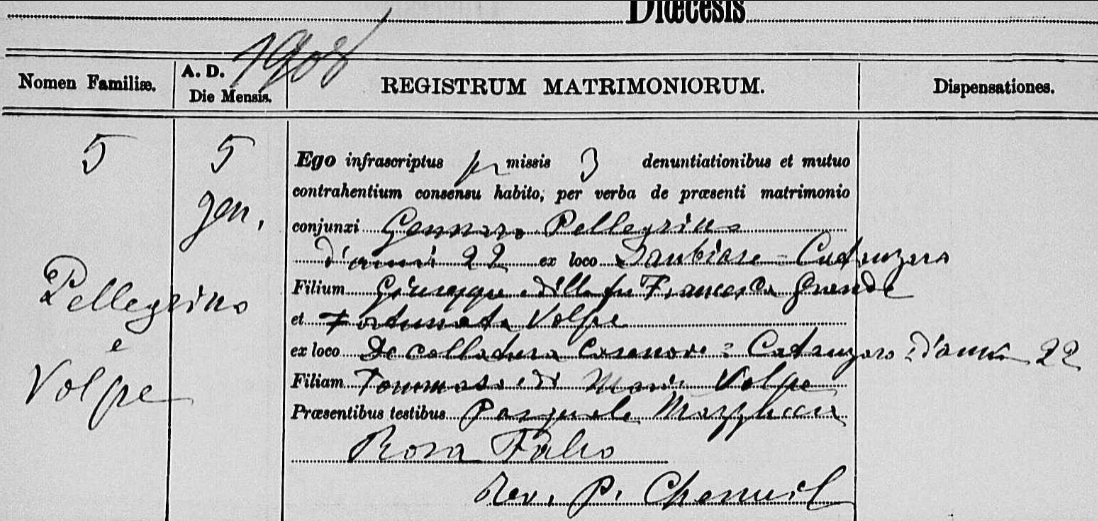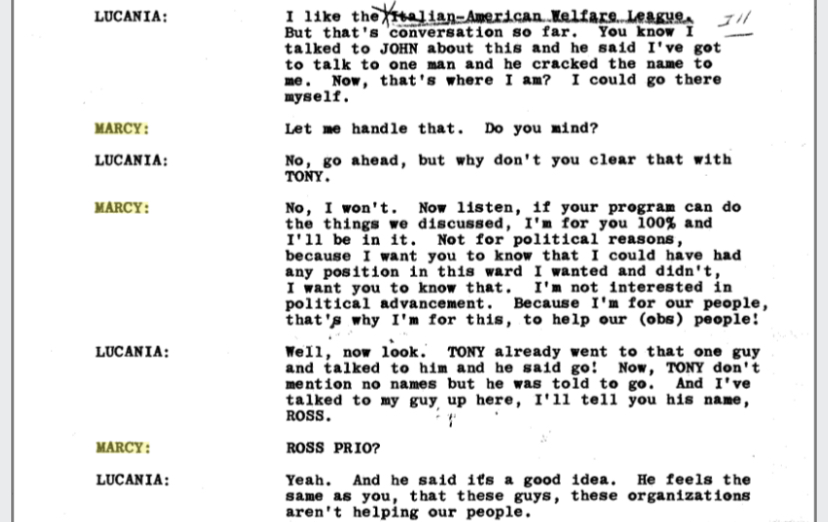Antonio "Mops" Volpe was born in 1892 in Santa Fe, Argentina, to Tomasso Volpe and Maria Perri of the frazione of Casenove in the comune of Decollatura, Catanzaro. The family returned to Calabria, as younger brother Domenico Volpe (who died in Cicero in 1948) was born in Decollatura. Later accounts stated that Mops Volpe arrived in the US illegally in 1906; his family can be located in Chicago by 1908, when eldest sister Fortunata Volpe married Gennaro Pellegrino, of Sambiase, Catanzaro (the hometown of the Rubertos and Liparotas/LaPortes) at Holy Guardian Angel Parish in the Taylor St Patch. In 1910, the Volpes were living with Gennaro and Fortunata in an apartment at Ewing (today Cabrini St) at Jefferson; Mops stated that he was working at a factor at this time. It's worth noting that probable mafioso Peppino Gambino, of Mazara del Vallo, who was murdered in 1910, was located close by at Jefferson and DeKoven. Gambino's son-in-law was a Francesco "Frank LaPorte" Liparota who was from Sambiase and may have been a cousin of the more famous Francesco Liparota of Chicago Heights. Like Mops Volpe, the Gambino/Liparota family was involved in the bloody mob wars of the 1920s in the Taylor St Patch.
viewtopic.php?p=222582#p222582
Antonio Volpe first appeared in the papers in 1916, already sporting the moniker "Tony Mops", when he was noted as operating a pool hall at Taylor and Blue Island (in coming years to be infamous as Genna/Trapanese Ground Zero) and accused of killing two men (Antonio "Joe/Pooch" Romagnono [sic] and Rocco "Hops" Carbone in a local gunfight (Mops claimed self-defense). Police claimed that Tony Mops was the head of local gang and that Pooch and Hops were members of a rival group. One of the alleged members of Volpe's group who was arrested with him at this time was noted in the papers by his nickname, "Nickelodeon"; Antiliar has stated that this was later Chicago member "Nicky Dean" Circella. It seems that a grand jury failed to indict Mops on the murder charges, as in 1917 he was shown as living at Taylor and Blue Island with his wife, Sara Johnston (who Mops married in 1915), and operating his pool hall; that same year, their son, Thomas Volpe, was born.
While in 1910, father Tomasso Volpe had been working as a street laborer, in a few years things were looking up for the Volpes. In 1917, Tomasso was operating a tavern at Taylor and Blue Island, near Mops's pool hall; eldest son Phillip Volpe (born in 1890 in Argentina; died in Chicago in 1947) was working for Tomasso as a bartender. I'm not positive, but this may have been the same tavern where Mops had engaged in the above gun battle. Another son, Giuseppe Volpe (born in 1893 in Argentina), had died in Chicago in 1911. By 1930, Mops's parents were living in Cicero at 19th & Cicero, just over the border from the city, with their youngest son Domenico. Tomasso Volpe died in 1948, while his wife Maria Perri Volpe died in 1953.
In 1921, the Tribune noted that Tony Mops was the secretary of Chicago member and Taylor St bigshot Diamond Joe Esposito; later articles would describe Mops as Esposito's "lieutenant", as well as Esposito's brother-in-law, though I wasn't able to verify a marriage connection between their families myself. Esposito was 20 years Mops's senior and his wife, Carmella Marchese, was born in Chicago to parents from San Fili, Cosenza (her mother was a Cesario, and thus it's possible that she was related to later Chicago member Sam Cesario, whose parents were also Cosentini).
In 1924, Mops Volpe was arrested with Messinese mobster Santo Gemelli and Cook County fire investigator Ben Newmark in a $1,000,000 war stamp counterfeiting ring. In 1928, Newmark was murdered after leaving prison, and the police questioned associates of Corleonese Chicago mafioso Giuseppe Nicolosi with regard to the killing (
viewtopic.php?p=241488#p241488). In 1925, the Tribune reported that a "Tony Volpe", "brother" of "Mops Volpe" was arrested for connections to a large Chicago narcotics distribution ring (this may have been brother Phillip Volpe).
Of course, by 1928 Mops Volpe was appearing in the papers as a top "bodyguard" and " chief lieutenant" of Capone, along with fellow Taylor St Allstars Frank Nitto and Frankie Rio. In 1929, Mops was one of 54 men pinched in a major raid of a "Capone gang" gambling operation at 2200 S Michigan Ave, reportedly headed by Charlie Fischetti. In December of 1930, Mops was arrested at his home at 1500 N Menard (at Lemoyne) in the Austin neighborhood on the Westside on a vagrancy warrant. After seizing him, the Feds attempted to deport Mops, on the grounds that as a non-citizen, he had re-entered the US within 5 years of committing a crime of "moral turpitude" (his 1925 counterfeiting conviction) when he arrived from Cuba at FL on a 1928 trip with fellow passengers then-City Sealer Dan Serritella (later State Senator; also described as a "Capone lieutenant" by the papers), former Alderman Al Prignano (murdered by the outfit in 1936), then-Alderman Billy Pacelli, Rocky Fischetti, and Jake Guzik. Mops had had his prior naturalization status as a US citizen revoked in 1920 by a judge, leaving him open to deportation. After months of diplomatic back-and-forth in 1931, a deportation order by the Secretary of Labor was thwarted when both Argentina and Italy refused to accept Volpe. Another deportation attempt in the 1944 failed for different reasons. This time, Volpe had been arrested with Jimmy Belcastro for reputed use of "terrorist" tactics to control a violent election for Republican Committeeman in the 25th Ward. The FBI got involved, and the US unsuccessfully ordered Volpe deported to Italy, where it was reported that he had been naturalized as a citizen as a child; now that Mussolini was out of office, the Feds knew that the US-backed post-War Italian government would play ball. Years of legal battles ensued, however, while Mops remained in the US in limbo; meanwhile, little brother Domenico Volpe hung himself by a trowel in a Cicero hotel room in 1947. Finally, in 1949 Mops was freed on a writ of habeas corpus referencing an earlier ruling by an appeals court judge that the 1920 recension of his citizenship had been performed improperly. in 1953, the Feds again attempted to deport Mops by stripping him of his citizenship, and again failed.
After these citizenship battles, tony Mops disappeared from the local papers, until his death from a heart attack while dining at a Cicero restaurant in 1965. At the time, Mops worked as a baker and was living with wife Sarah in a two-flat at 1255 N Menard (at Potomac) in the Austin neighborhood. The Tribune reported that his funeral was attended by only a very small number of family and friends.
Marriage of Fortunata Volpe and Gennaro Pellegrino at Holy Guardian Angel Parish in 1908:


